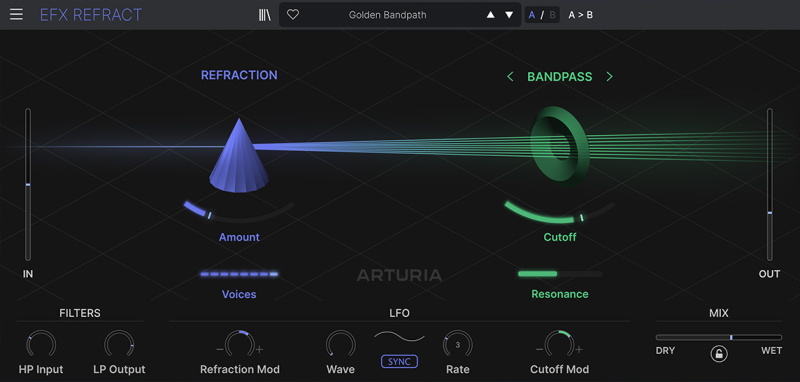Arturia Efx REFRACT

Efx REFRACT is a stereo multi-effect with versatility at its core. Combining unison-based processing with a variety of secondary effects and modulation options, effortlessly enrich, texturise and transform any sound - from experimental distortions to detuned harmonics. Based on super unison architecture, Efx REFRACT delivers instantaneous size and character to your sound. Whether marking key moments or making sweeping transformations - bring any track to life with flare and multi-effect dispersion.
Unison refers to a process of multiplication, where the same sound or note is duplicated and played in parallel. Like a string section in an orchestra, which has a wonderfully rich sound as a result of many instruments playing at once, unison replicates this for a chorus-like effect; with slight differences in phase leading to a sound that is more filled-out and enriched.
Efx REFRACT takes this multi-vocal approach to enlarge and extend the width of a sound, which you can choose to do with or without the addition of powerful Mode FX. It takes any audio source and spreads it across a dynamic and modifiable FX chain, allowing you to add energy, movement and power to your heart’s content.
Overview:
- Refraction: The Refraction section of the plugin takes your input and can duplicate it up to 8 stereo voices. The Refraction ‘Amount’ then increasingly detunes and modulates each voice against one another to widen them. You can use this on its own to thicken and widen an input sound without additional FX.
- Mode FX: The plugin comes with five additional Mode FX (BandPass Filter/Comb Filter/Bitcrusher/Distortion/Harmonizer) which are added onto each Refracted voice and processed individually, before being recombined at the output. This unique approach allows for novel, wild and creative results with only a few simple controls.
- FX Dispersion: The Refraction ‘Amount’ disperses the chosen Mode Effect on each of the ‘Voices’. Play around with the relationship between the Refraction Amount and Voices, and how setting them impacts the Mode FX controls.
- Filters: Use the ‘Input HP’ to filter out some of the low frequencies from your input, which can help clean up the Distortion & Bitcrusher modes, and use the ‘Output LP’ to tame the Effect’s high frequencies and remove some harshness to get smoother results.
- LFO: Use the LFO ‘Wave’ to smooth things out or create choppy chaotic modulations. Experiment with the LFO rate to change the dynamics of the refraction amount.
 How to resolve AdBlock issue?
How to resolve AdBlock issue?